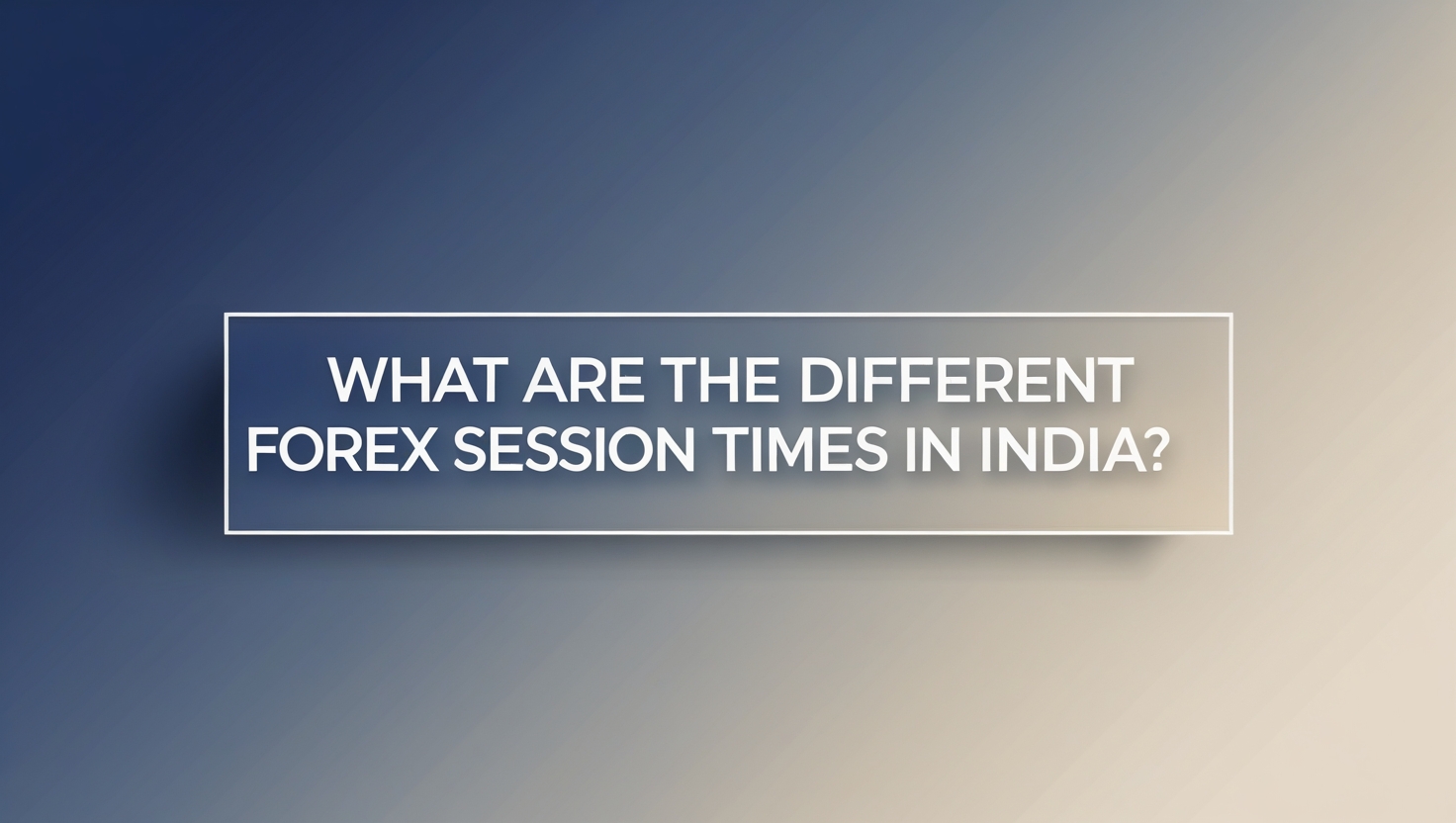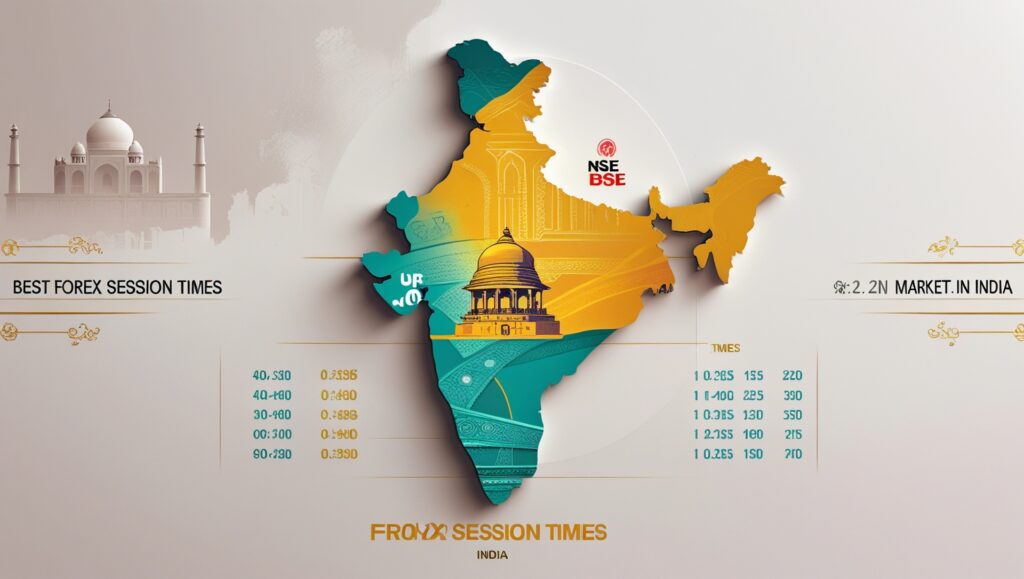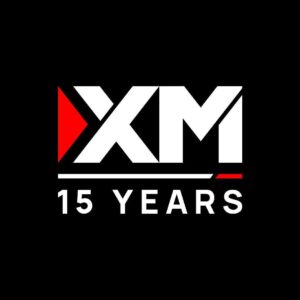
The foreign exchange (forex) market never sleeps, operating 24 hours a day from Monday to Friday as global financial centers pass the baton across time zones. In Indian Standard Time (IST), this translates into distinct trading sessions. For example, the global currency market “opens in India on Mondays at 3:30 AM IST” and closes early Saturday morning. However, note that domestic forex trading in India (INR currency pairs) is regulated: it officially runs 9:00 AM–5:00 PM IST (with non-INR currency pairs trading until 7:30 PM). Understanding forex session times in India means aligning both the domestic schedule and the major international trading windows so educators and traders can spot the right moments to trade.
Overview : Forex Session Times in India
| Trading Session | IST Timing | Key Characteristics | Best For | Volatility Level |
|---|---|---|---|---|
| Sydney (Pacific) | 3:30 AM – 11:30 AM | Quieter session, focuses on AUD/NZD pairs | Asia-Pacific currency pairs | Low |
| Tokyo (Asian) | 5:30 AM – 1:30 PM | Asian economic data releases, JPY activity | JPY and Asian currency pairs | Medium |
| London (European) | 1:30 PM – 9:30 PM | Largest trading center (38% global turnover) | EUR/GBP pairs, trend following | High |
| New York (US) | 6:30 PM – 2:30 AM | USD pairs activity, overlaps with London | USD-related pairs | High |
| Session Overlap | IST Overlap Time | Trading Activity | Recommendation |
|---|---|---|---|
| Sydney + Tokyo | 5:30 AM – 11:30 AM | Moderate | Good for AUD/JPY crosses |
| London + New York | 6:30 PM – 9:30 PM | Peak Activity | ⭐ BEST TIME – Highest liquidity |
| Market Type | Official Trading Hours (IST) | Important Notes |
|---|---|---|
| Indian Rupee (INR) Pairs | 9:00 AM – 5:00 PM | RBI regulated domestic forex |
| Non-INR Currency Pairs | 9:00 AM – 7:30 PM | Extended hours for international pairs |
Forex Session Times in India: Global Trading Hours
The 24/5 nature of FX trading arises from overlapping regional markets. In IST, the four main sessions are:
- Sydney (Australia/Pacific) Session: 3:30 AM – 11:30 AM IST
- Tokyo (Asian) Session: 5:30 AM – 1:30 PM IST
- London (European) Session: 1:30 PM – 9:30 PM IST
- New York (U.S./North American) Session: 6:30 PM – 2:30 AM IST
These times account for clock differences and daylight saving shifts. Each period is dominated by local markets and currencies. The Sydney session (IST 3:30–11:30 AM) tends to be quieter, focusing on the Australian and New Zealand Dollars (AUD, NZD). The Tokyo session (5:30 AM–1:30 PM IST) picks up liquidity with Japanese and Asian economic data. As evening approaches India, the London session (1:30–9:30 PM IST) roars to life – it is the largest trading center worldwide (it accounts for roughly 38% of global FX turnover) and is when EUR, GBP, and USD pairs see heavy action. Finally, the New York session (6:30 PM–2:30 AM IST) overlaps London for a few hours, driving spikes in volatility for USD-related pairs around U.S. market open.
The table below summarizes all forex session times in India in IST:
| Session (Region) | Local Market | IST Open | IST Close |
|---|---|---|---|
| Sydney (Pacific) | Australia | 3:30 AM | 11:30 AM |
| Tokyo (Asian) | Japan | 5:30 AM | 1:30 PM |
| London (European) | UK/Europe | 1:30 PM | 9:30 PM |
| New York (North Am.) | US | 6:30 PM | 2:30 AM |
Table 1: Major Forex Trading Sessions and Their Times in India Standard Time (IST). These are continuous market hours (5 days per week) defined by global financial centers.
As the table shows, sessions overlap at certain times. For example, the Sydney and Tokyo sessions overlap from 5:30–11:30 AM IST, and the big London–New York overlap occurs from 6:30–9:30 PM IST. Such overlaps are when trading activity peaks. In fact, Investopedia notes that sessions “sometimes overlap, such as a four-hour period for peak activity in both Europe and North America”. In practice, the London–New York overlap (evening IST) is the most liquid period globally. This overlap sees multiple markets open at once, causing volatility to soar. As one trader put it, “the U.S./London markets overlap… have the heaviest trading, and are likely to provide the most trading opportunities”. In contrast, the Sydney–Tokyo overlap is milder (typically mid-morning IST) and mostly moves AUD/JPY or other Asia-Pacific crosses.
Best Forex Session Times in India
With the schedule in hand, the next question is: When should Indian traders jump in? There is no perfect answer, but there are “best” times that many seasoned traders target. A generally agreed rule is to trade during high-liquidity overlaps or session opens. The prime window is the London–New York overlap (6:30–9:30 PM IST). During this time the European market is winding down and U.S. banks are starting the day, causing a surge in volume and volatility. For example, major pairs like EUR/USD and GBP/USD often have large moves then, driven by news from both continents.
Indeed, an IG analyst notes that the London–New York overlap is often the most liquid period – “the FX market often experiences greater volatility during the London-New York overlap”.
Another key window is the start of the London session (1:30–3:30 PM IST). When London opens for business, fresh orders flood in from European banks and news releases. This early London session period is often strong for trend-following moves, especially if there is economic data out of Europe. One guideline: if you want to trade EUR or GBP pairs, aim for 1:30–3:30 PM IST.
In the morning, the Tokyo session (5:30 AM–1:30 PM IST) can suit traders focusing on JPY or Asian currency pairs. However, volatility tends to be lower until the middle of its window. The Sydney session (pre-dawn IST) is usually quiet – sometimes called the “Australian lull.” A few minutes of liquidity pick up when Sydney opens, but many Indian traders stay in bed during these hours.

Finally, it is important to consider your own schedule and risk tolerance. Trading at 6:30 PM IST every day is not practical for everyone. For some, the “best forex session times in India” might simply be when they are awake and can monitor the markets.
As one might ask rhetorically: “Why be an early bird at 5 AM if the price isn’t moving yet?” Conversely, night owls may prefer the late U.S. session. In short, the best time depends on which currency pairs you trade and your personal strategy – but statistically, the 1:30–3:30 PM IST and 6:30–9:30 PM IST windows are often most active.
Overlaps and Liquidity
Periods when two sessions overlap offer the most liquidity and volatility. The London–New York overlap is the obvious example, but there is also a shorter Tokyo–London handoff. In India, the Tokyo session ends exactly when the London session begins (around 1:30 PM IST), so there is virtually no gap in trading, but also only a brief overlap. By contrast, the Sydney–Tokyo overlap (5:30–11:30 AM IST) is several hours long. Traders who trade yen or Aussie pairs may use that overlap, though volumes are still far below the afternoon peaks.
In all cases, remember: high volatility means opportunity and risk. Traders who thrive on rapid moves (scalpers, some day traders) eagerly seek out these overlap hours. Others prefer the Asian session’s quieter price action.
As Investopedia summarizes: “the best time to trade is during overlaps between open markets,” since these overlaps usually mean higher trading ranges and more chances for profit.
Tables of Forex Session Times
To help educators and traders, we have compiled all key forex session timings in IST into tables. These tables list the opening and closing times of each major session, plus their overlap periods. Below is an overview, and a downloadable version is also available for offline use (see Resources or our website for the PDF/spreadsheet).
| Session Pair | IST Overlap Hours | Notes |
|---|---|---|
| Sydney & Tokyo | 5:30 AM – 11:30 AM IST | Australian and Asian overlap |
| London & New York | 6:30 PM – 9:30 PM IST | Major overlap, peak activity |
| London & Tokyo | 1:30 PM (none) | Tokyo ends as London opens |
| Sydney & London | None | Disjoint sessions |
Table 2: Overlapping Forex Session Periods (IST). Overlaps are when multiple markets trade simultaneously, often boosting volume.
In practice, many Indian traders focus on the London and New York windows, because these overlap periods offer “the heaviest trading” according to market analysts. However, the charts above show that other overlaps exist and may suit niche strategies. Whichever session you trade, make sure to check whether daylight savings time (DST) shifts might adjust the clock by an hour in summer months.
Expert Insights
Regulatory and market experts also note the shift toward extended forex hours globally. In India, the Reserve Bank (RBI) has a working group reviewing market timings. RBI Governor Sanjay Malhotra observed that, “Over the last few years… the availability of forex and certain interest rate derivative markets [is] on a 24×5 basis”, reflecting how technology and international participation have made currency markets effectively round-the-clock. While India’s official trading windows remain 9–5, traders should be aware that the global forex “round table” now spans nearly all waking hours in India. In other words, even if one session closes, another is about to open somewhere in the world.
Conclusion
Timing is crucial in forex. By mapping the forex session times in India and noting key overlaps, financial educators can guide students to understand when markets are most active. Always align trading plans with session schedules. Keep an economic calendar handy (U.S. and European news often hit during IST afternoon/evening), and remember RBI’s regulated hours for INR pairs. With this knowledge and the above tables at hand, Indian traders can plan their strategies around the “clockwork” of global markets.

















